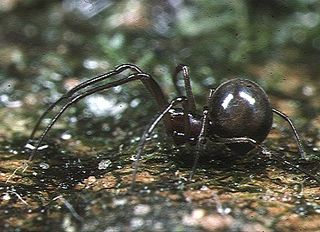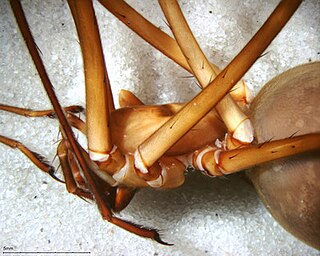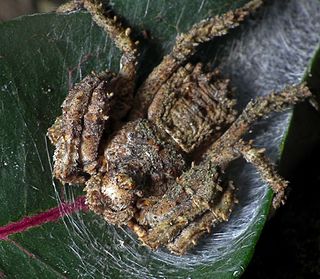
Amaurobiidae is a family of three-clawed cribellate or ecribellate spiders found in crevices and hollows or under stones where they build retreats, and are often collected in pitfall traps. Unlidded burrows are sometimes quite obvious in crusty, loamy soil. They are difficult to distinguish from related spiders in other families, especially Agelenidae, Desidae and Amphinectidae. Their intra- and interfamilial relationships are contentious. According to the World Spider Catalog, 2023, the family Amaurobiidae includes 286 species in 50 genera.
Ligonipes is a spider genus of the jumping spider family, Salticidae. Five of the six described species are found in the Australian region, the exception being Ligonipes similis, recorded as being from Sumatra. Their body form mimics ants.

Anapidae is a family of rather small spiders with 232 described extant species in 58 genera. It includes the former family Micropholcommatidae as the subfamily Micropholcommatinae, and the former family Holarchaeidae. Most species are less than 2 millimetres (0.079 in) long.

Macrogradungula is a monotypic genus of Australian large-clawed spiders containing the single species, Macrogradungula moonya. It was first described by Michael R. Gray in 1987, and has only been found in Australia. It is classified under the family Gradungulidae, superfamily Austrochiloidea, and suborder Araneomorphae.
Dardurus is a genus of Australian tangled nest spiders first described by V. T. Davies in 1976.
Midgee is a genus of Australian araneomorph spiders in the family Toxopidae, first described by V. T. Davies in 1995.
Storenosoma is a genus of Australian tangled nest spiders first described by Henry Roughton Hogg in 1900.
Barahna is a genus of Australian intertidal spiders that was first described by V. T. Davies in 2003. The name is derived from baran-barahn, the Bundjalung word for "spider". Originally placed with the Stiphidiidae, it was moved to the intertidal spiders after the results of a 2017 genetic study.
Carbinea is a genus of Australian sheetweb spiders that was first described by V. T. Davies in 1999.
Kababina is a genus of Australian sheetweb spiders that was first described by V. T. Davies in 1995.
Malarina is a genus of Australian sheetweb spiders that was first described by V. T. Davies & C. L. Lambkin in 2000.
Wabua is a genus of Australian sheetweb spiders that was first described by V. T. Davies & C. L. Lambkin in 2000.
Hickmanolobus is a genus of Australian araneomorph spiders in the family Orsolobidae, and was first described by Raymond Robert Forster & Norman I. Platnick in 1985.
Tasmanoonops is a genus of Australian araneomorph spiders in the family Orsolobidae, and was first described by V. V. Hickman in 1930.
Anarchaea is a genus of Australian shield spiders that was first described by Michael Gordon Rix in 2006.
Ozarchaea is a genus of South Pacific shield spiders that was first described by Michael Gordon Rix in 2006.

Stephanopis is a genus of crab spiders first described by Octavius Pickard-Cambridge in 1869. It was erected for five then newly described species, including S. altifrons, from Australia. Stephanopis was characterized by the high cephalic region with unequally sized anterior eyes disposed in a strongly recurved row, opisthosoma ending in several spiniform projections and dorsoventrally depressed habitus. According to Pickard-Cambridge, the single specimen used for the description of S. altifrons was dry-pinned. Therefore the specimen could not be properly examined, so it was not possible to determine if the specimen was adult. Moreover, he states his own sketch of the spider as “hasty” or "dull". This may explain why the somatic characters were inadequately described, genitalic features were not mentioned at all, and the illustrations were not detailed enough, making the species unidentifiable.



